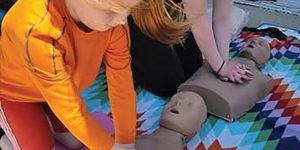
There’s nothing like a major milestone in a child’s life to test a parent’s confidence. Big changes like a new school or classroom can be trying for kids and adults alike, but tackling the transition a little at a time can make it easier on everyone.
Most parents agree that being confident is important, but only about 1 in 3 parents feels confident on a typical day, according to KinderCare’s Parent Confidence Report. However, experts say your own feelings can impact youngsters.
Whether your child is making a big change like stepping up from pre-K into kindergarten or entering a new grade in the same building, there’s likely to be some trepidation. However, each child is different, which means reactions to change can vary.
Some kids show up ready and raring to go, eager to explore and meet new friends, while others can be a little clingy, tearful or even refuse to look at the teacher or take a step through the door.
If you think your child might have trouble making the transition, consider these strategies from the experts at KinderCare to help ease both of you into a more comfortable place and build confidence for a successful school year.
Set up classroom visits before school starts. Sometimes fear comes from the unknown. By visiting ahead of time and seeing firsthand, your child can become familiar with the layout of the classroom, meet the teachers and know what to expect, which can help alleviate some of the anxiety and jitters.
Talk with your child’s teacher about the transition. Your child’s teacher should be your partner, so be open and honest from the start. Talk about how your child handles change, what causes stress or what behaviors the teacher might expect. Don’t be afraid to call and ask for updates on your child to see how things are going. Set up regular check-ins over the next few weeks to talk about any additional support your child may need.
Avoid sneaking away from your child at drop-off. Talk about what will happen ahead of time and create a consistent and predictable drop-off ritual, such as two high-fives, a hug and a wave from the window, to ensure your child feels secure and safe. Continue this routine every day to help your child get used to the classroom environment and make sure the process is a quick, happy one. While you’re typically welcome in most classrooms, lingering too long can make it harder on your child once you do leave.
Be enthusiastic. Just like laughter, excitement is contagious. Rather than focus on nerves or uncertainty, share your own memories from school including how you felt at the beginning of a new school year and the excitement of learning and meeting new friends, which can help your child get hyped up, too.
Set up a workstation at home. Creating a designated space at home for your little learner to do homework, read, write, draw and complete art projects can help set him or her up to develop good study habits. Stock this station with colored paper, crayons and markers, pencils, glue sticks, scissors, books, stickers and other necessary tools, and leave room for stowing a backpack. Encourage your child to spend time working on educational endeavors in the space each night.
View the full Parent Confidence Report and find more advice to help ease your child’s way into the school year at KinderCare.com.
Facilite la vuelta a la escuela de los niños con confianza
No hay nada como un hito importante en la vida de un niño para poner a prueba la confianza de los padres. Grandes cambios, como una nueva escuela o aula, pueden ser difíciles para niños y adultos por igual, pero abordar la transición poco a poco puede hacer que sea más fácil para todos.
La mayoría de los padres están de acuerdo en que la confianza es importante, pero sólo cada uno de tres padres se siente confiado en un día regular, según el Informe de Confianza de Padres de KinderCare. Sin embargo, los expertos dicen que sus propios sentimientos pueden afectar a los pequeños.
Si su hijo está haciendo un gran cambio, como pasar de preescolar al jardín de infantes o ingresar a un nuevo grado en el mismo edificio, es probable que haya cierta inquietud. Sin embargo, cada niño es diferente, lo que significa que las reacciones al cambio pueden variar.
Algunos niños aparecen listos y con muchas ganas de ir, ansiosos por explorar y conocer nuevos amigos, mientras que otros pueden ser un poco pegajosos, llorosos o incluso rehusarse a mirar a la maestra o dar un paso por la puerta.
Si piensa que su niño podría tener problemas para hacer la transición, considere estas estrategias de los expertos de KinderCare para ayudar a que ambos se encuentren en un lugar más cómodo y generen confianza para un año escolar exitoso.
Organice visitas al salón antes de que comiencen las clases. A veces, el miedo viene de lo desconocido. Al visitar con anticipación y ver por su cuenta, su niño puede familiarizarse con el diseño del aula, conocer a los maestros y saber qué esperar, lo que puede ayudar a aliviar algo de la ansiedad y el nerviosismo.
Hable con el maestro de su hijo sobre la transición. El maestro de su hijo debe ser su compañero, así que sea abierto y honesto desde el principio. Hable sobre cómo su hijo maneja los cambios, qué causa estrés o qué comportamientos puede esperar el maestro. No tenga miedo de llamar y pedir actualizaciones sobre su hijo para ver cómo van las cosas. Programe visitas regulares durante las próximas semanas para hablar sobre cualquier apoyo adicional que su hijo pueda necesitar.
Evite huir de su hijo al dejarlo. Hable sobre lo que sucederá antes de tiempo y cree un ritual de entrega consistente y predecible, como dos chocadores, un abrazo y un saludo desde la ventana, para asegurarse de que su hijo se sienta seguro. Continúe esta rutina todos los días para ayudar a su hijo a acostumbrarse al entorno del aula y asegúrese de que el proceso sea rápido y feliz. Si bien normalmente es bienvenido en la mayoría de los salones de clase, demorarse demasiado puede dificultar la tarea de su hijo una vez que se vaya.
Sea entusiasta. Al igual que la risa, la emoción es contagiosa. En lugar de centrarse en los nervios o la incertidumbre, comparta sus propios recuerdos de la escuela, incluido cómo se sintió al comienzo de un nuevo año escolar y la emoción de aprender y conocer nuevos amigos, lo que puede ayudar a que su hijo se sienta emocionado, también.
Configure una estación de trabajo en casa. Crear un espacio designado en casa para que su pequeño aprendiz pueda hacer tareas, leer, escribir, dibujar y completar proyectos de arte puede ayudarlo a prepararse para desarrollar buenos hábitos de estudio. Almacene esta estación con papel de colores, crayones y marcadores, lápices, barras de pegamento, tijeras, libros, pegatinas y otras herramientas necesarias, y deje espacio para guardar una mochila. Anime a su hijo a pasar tiempo trabajando en actividades educativas en el espacio cada noche.
Vea el Informe de Confianza de Padres completo y encuentre más consejos para ayudar a facilitar la entrada de su hijo al año escolar en KinderCare.com.










